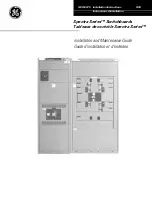
Protection Settings
46
TemBreak
PRO
P_SE-UM-001-EN
– V1.2.0
Zone Selective Interlocking Function (ZSI)
Zone interlocking is a high-speed signalling method applied between multiple combinations of MCCBs and ACBs to improve the level of protection in a low
voltage power distribution system.
A ZSI signalling cable is connected between the downstream and upstream protective devices, permitting the circuit breakers to signal at high speed to
each other to determine whether either circuit breaker has detected a short-time (I
sd
) or ground-fault (I
g
) event and to co-ordinate zone selective tripping with
minimal time delay.
The circuit breaker closest to the fault will attempt to clear the fault early without relying on varied time delay (t
sd
and t
g
) settings between upstream and
downstream circuit breakers to co-ordinate selectivity. This has potential to reduce the overall tripping time of the power distribution network and reduction in
incident energy without disruption to other services.
When the OCR detects a fault current in the STD and/or GF protection curve areas (equal or in excess of I
sd
and I
g
respectively) it closes an internal contact
on its ZSI output port (ZSI
2
), permitting a signal to propagate along the ZSI signalling cable between upstream and downstream circuit breakers. This is
done regardless of whether ZSI is enabled in the OCR.
Only when ZSI is enabled for the required protection type, the OCR will also await a signal from its ZSI input port (ZSI
1
) from the downstream breaker. If
there is no signal on the ZSI input ZSI
1
then the OCR determines that the fault has occurred closest to itself. The ZSI function overrides any time delay
settings for the respective fault type (STD and GF protection, t
sd
and t
g
respectively) and the circuit breaker will initiate an instantaneous trip and clear the
fault as soon as possible
(total clearing time may be within 20…50ms).
If a signal is detected on ZSI input ZSI
1
port, then the circuit breaker downstream will initiate the trip. Time delay settings t
sd
and t
g
of the circuit breaker and
all other upstream circuit breakers are not overridden and will trip with the configured delays in the event that the downstream circuit breaker is unable to
clear the fault in time.
WARNING
: The ZSI function is supplementary to time selectivity (t
sd
and t
g
time delay). Under no circumstances
shall it be used to replace normal STD and/or GF protection.
Notice
: The use of the ZSI signal requires the connection of ZSI Signalling cables to either or both of the
required ZSI ports located under the front cover of the P_SE MCCB. Refer to the
details on the ZSI cable.
Содержание Terasaki TemBreak PRO P SE Series
Страница 106: ...106 TemBreak PRO P_SE UM 001 EN V1 2 0 Annex A Dimensions P160 Dimensions...
Страница 107: ...Annex A Dimensions 107 TemBreak PRO P_SE UM 001 EN V1 2 0 P250 Dimensions...
Страница 108: ...Annex A Dimensions 108 TemBreak PRO P_SE UM 001 EN V1 2 0 P400 Dimensions...
Страница 109: ...Annex A Dimensions 109 TemBreak PRO P_SE UM 001 EN V1 2 0 P630 Dimensions...
Страница 111: ...111 TemBreak PRO P_SE UM 001 EN V1 2 0 Annex C I2t Let Through Curves P160_SE...
Страница 112: ...Annex C I2t Let Through Curves 112 TemBreak PRO P_SE UM 001 EN V1 2 0 P250_SE...
Страница 113: ...Annex C I2t Let Through Curves 113 TemBreak PRO P_SE UM 001 EN V1 2 0 P400_SE...
Страница 114: ...Annex C I2t Let Through Curves 114 TemBreak PRO P_SE UM 001 EN V1 2 0 P630_SE...
Страница 115: ...115 TemBreak PRO P_SE UM 001 EN V1 2 0 Annex D Peak Let Through Curves P160_SE...
Страница 116: ...116 TemBreak PRO P_SE UM 001 EN V1 2 0 P250_SE...
Страница 117: ...117 TemBreak PRO P_SE UM 001 EN V1 2 0 P400_SE...
Страница 118: ...118 TemBreak PRO P_SE UM 001 EN V1 2 0 P630_SE...
Страница 121: ...121 TemBreak PRO P_SE UM 001 EN V1 2 0 This page is intentionally left blank...














































